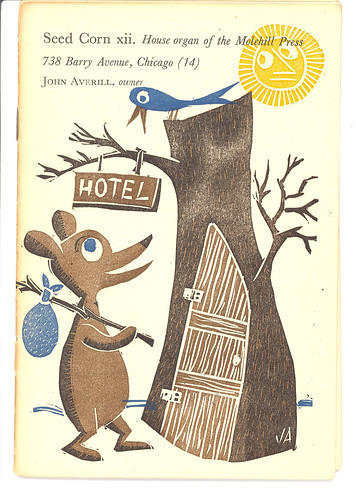
I discovered a monograph (see end for info) in a local used bookstore, and knew right away that I wanted to know more about this fellow and his work. How could I not? Within the practical lifetime of printing (when presses were still necessary tools, unlike today), he was trying different ways of using them and the accessories-the type, the ink, the paper-to create art that communicated to anyone who would look at it.
Hendrick Nicolaas Werkman
Dutch printer/artist/revolutionary working ~1920 to 1945 when he was executed by the Nazis.
He lived and worked in Groningen, and did not travel much (he was but a poor printer), so his exposure to the outside world(s) of art and thought were mainly from correspondence with fellow artists in other cities and the various periodicals he collected from around the world and was involved with (as a printer and contributor); later in his career, some of the projects that he printed-and was asked to print but decided not to-(the Nazis controlled everything and quashed anything that was not pro-German or at least not overtly and obviously anti-German) were a source of new ideas but also anxiety, as Werkman worried about his actions harming innocent neighbors. He ran his print shop in a building that had other tenants. Some of those projects included 20 prints for portfolios of Hasidic legends, and a somewhat sporadic periodical called Die Blauwe Schuit (The Blue Barge) that contained poetry, writings and artwork to boost the Dutch spirit during the German occupation.
Werkman belonged to de Ploeg, a Groninger artist collective, but seemed regularly at odds with them. They considered him, a printer, a lesser artist and he thought they were too unbending in seeking out new ways to communicate their ideas, and perhaps he found them to be smaller thinkers since they refused to be open to pushing forward and broadening their consideration of what could be categorized as art and making art. He worked within the collective to try to bring about some opening of the minds of his fellow de Ploeg members and some of them appreciated his work, but by and large they considered him minor.
For Werkman, the Constructivists were too rigid and narrow minded (which is where the de Ploeg members fell). And the Dadaists were too frivolous and treated their work as too trivial.
Werkman worked organically, creating on the press as he went: “The subject proclaims itself and is never sought.”
He printed publications for de Ploeg, as well as other art collectives, and in order to push the boundaries of the definitions of printing and art produced his own periodical, called The Next Call, that are color saturated feasts for the eyes. The narrative was minimal, mainly in support of his manifesto to go boldly forward in the making of art including poetry, though there are some phrases that stuck with me:
EEN RIL DOORKLIEFT (a chill permeates)
HET LIJF DAT VREEST (the body that fears)
DE VRIJHEID VAN DE GEEST (the freedom of the soul)
[Both for how they appear in the original language, but also for their poetry.]
In addition to using a press, ink, rollers and type to create his own periodical, he also used stencils that he made to create figures and abstract forms with ink on the press. He called his monotypes druksels (concocted from the Dutch infinitive drukken, to print), and he also used a typewriter to create tiksels (tikken, to type). He also produced calendars and artworks to illustrate poems and stories.
He is inspiring for his obvious pure delight in pursuing his art, his creativity and use of type and color and shape, and his undiminished enthusiasm for connecting with others in the art world and beyond, his willingness to carry on in the face of oppression and danger and his humanity.
A lot of his work was destroyed by the Nazis, but luckily some of it survived (bought by supporters, and one cabinet in his shop survived a bombing that destroyed pretty much everything else). Exhibitions of his work have taken place since his death, but his contributions to the worlds of art and graphic design are still debated, unfortunately.
Above is a selection of calendar pages from 1944, and below, The Next Call #9.
Information and scans from H.N. Werkman, by Alston W. Purvis. ISBN: 1-85669-389-9. Published in the UK by Laurence King Publishing.




